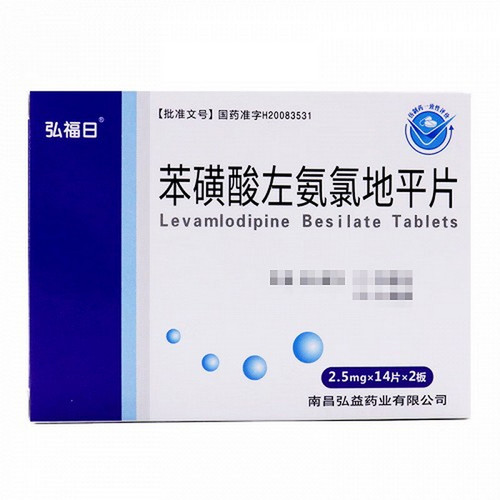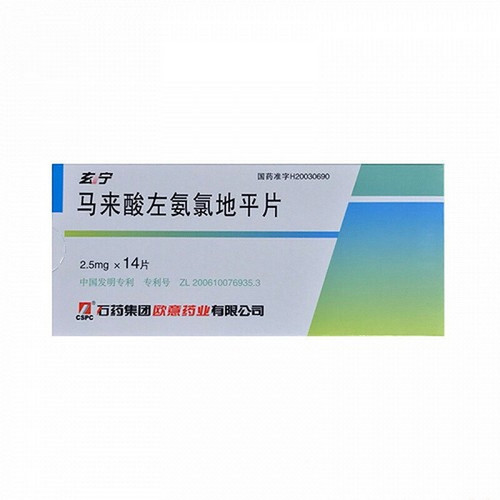Product Overview
[Drug Name]
Generic Name: Levamlodipine Besylate Tablets
Trade Name: Zuoyi
English Name: Levamlodipine Besylate Tablets
Chinese Pinyin: Benhuangsuan Zuoxuan'anlüdiping Pian
[Ingredients]
The main ingredient and its chemical name are: (-)3-ethyl-5-methyl-2-(2-aminoethoxymethyl)-4-(2-chlorophenyl)-1,4-dihydro-6-methyl-3,5-pyridinedicarboxylate benzenesulfonate
[Properties]
This product is a white tablet.
[Indications]
1. Hypertension (used alone or in combination with other medications)
2. Angina pectoris: especially spontaneous angina (used alone or in combination with other medications)
[Dosage and Administration]
The usual starting oral dose is 5 mg once daily, with a maximum of 10 mg once daily. For thin patients, those with frail constitutions, elderly patients, or those with impaired liver function, the dosage should be started at 2.5 mg once daily. Patients taking other antihypertensive medications should also start at this dose. The dosage should be adjusted based on individual needs, and the adjustment period should be at least 7-14 days to allow the physician to fully assess the patient's response to the dose. However, faster adjustment can be performed if clinically warranted. The recommended dose for the treatment of angina pectoris is 5-10 mg; elderly patients or those with impaired liver function may require a reduced dose.
[Adverse Reactions]
This drug is well tolerated by patients. 1. Less common side effects include headache, edema, fatigue, insomnia, nausea, abdominal pain, flushing, palpitations, and dizziness. 2. Extremely rare side effects include itching, rash, dyspnea, weakness, muscle cramps, and indigestion. 3. Similar to other calcium channel blockers, there have been rare reports of adverse reactions such as myocardial infarction and chest pain, and these reactions cannot be clearly distinguished from the patient's underlying medical condition. 4. No abnormal laboratory parameters have been found related to this drug.
[Contraindications]
Allergy to dihydropyridine calcium channel blockers.
[Precautions]
1. Angina and/or Myocardial Infarction: Rare. Patients with severe obstructive coronary artery disease may experience an increase in the frequency, duration, and/or severity of angina attacks, or the development of acute myocardial infarction, when initiating or increasing the dose of calcium channel blockers. The mechanism is unknown. 2. Hypotension: Due to the gradual vasodilatory effect of this drug, acute hypotension is generally rare with oral administration. However, caution is advised when this drug is used in combination with other peripheral vasodilators, especially in patients with severe aortic stenosis. 3. Patients with Heart Failure: Calcium channel blockers should be used with caution in patients with heart failure. 4. Patients with Hepatic Impairment: This drug should be used with caution in patients with severe hepatic insufficiency.
[Use in Special Populations]
Precautions in Pediatrics:
There are no data on the use of this drug in children.
Precautions during Pregnancy and Lactation:
This drug is recommended only when there are no safer alternatives or when the underlying medical condition poses a greater risk to the mother and child. Elderly Precautions:
Elderly patients can use the normal dose. However, it is advisable to start with a lower dose and then gradually increase it.
[Drug Interactions]
1. This product is safe to use with the following drugs: thiazide diuretics, beta-blockers, angiotensin-converting enzyme inhibitors, long-acting nitrates, sublingual nitroglycerin, nonsteroidal anti-inflammatory drugs, antibiotics, and oral hypoglycemic agents. 2. In healthy volunteers, co-administration of this product with digoxin did not alter digoxin plasma concentrations or renal clearance; co-administration of this product with cimetidine did not alter its pharmacokinetics. 3. In vitro studies indicate that this product has no effect on the plasma protein binding of digoxin, phenytoin, warfarin, or indomethacin. 4. In healthy male volunteers, co-administration of this product with warfarin did not affect warfarin's changes in prothrombin time.
[Pharmacology and Toxicology]
Amlodipine besylate is a dihydropyridine calcium antagonist (calcium ion antagonist or slow-channel blocker). Cardiac and smooth muscle contraction depends on extracellular calcium ion entry through specific ion channels. This drug selectively inhibits transmembrane calcium entry into smooth muscle cells and cardiomyocytes, with a greater effect on smooth muscle than on myocardium. Its interaction with calcium channels is determined by the progressive rate of binding and dissociation between receptor sites, resulting in a gradual onset of pharmacological action. This drug is a peripheral arterial dilator, acting directly on vascular smooth muscle to reduce peripheral vascular resistance and thereby lower blood pressure. At therapeutic doses, negative inotropic effects have been observed in vitro but not in whole animal studies. This drug does not affect plasma calcium concentrations. Fifteen randomized, double-blind, placebo-controlled clinical trials have confirmed its antihypertensive activity. Once daily, it can lower supine and standing blood pressure in patients with mild to moderate hypertension for 24 hours. Long-term use does not cause significant changes in heart rate or plasma catecholamine levels. The antihypertensive effect is steady, with minimal differences between peak and trough values. The antihypertensive effect is dose-dependent, and the magnitude of the reduction is related to pre-treatment blood pressure. Patients with moderate hypertension (diastolic blood pressure 105-114 mmHg) experience greater efficacy than those with mild hypertension (diastolic blood pressure 90-104 mmHg), while those with normal blood pressure experience no significant effect. The diastolic blood pressure-lowering effect of this drug is similar in older and younger adults, while the systolic blood pressure-lowering effect is stronger in older adults. The precise mechanism by which this drug alleviates angina is unclear, but it may be that during exercise, this drug reduces cardiac work and the rate-blood pressure product by reducing peripheral resistance (afterload), thereby reducing myocardial oxygen demand and treating exertional angina. It also treats spontaneous angina by inhibiting calcium ion, epinephrine, 5-hydroxytryptamine, and thromboxane A2-induced coronary artery and arteriolar constriction, thereby restoring blood flow to the ischemic area. Five of eight clinical trials demonstrated that this drug significantly prolonged the duration of exercise-induced exertional angina. Some studies have also shown that this drug prolongs the time to a 1mm ST segment change and reduces the frequency of angina attacks. This effect is sustained and does not significantly affect blood pressure or heart rate. A clinical trial in 50 patients with spontaneous angina pectoris showed that this product reduced angina attacks by four per week (placebo reduced it by one per week). Hemodynamics at rest and during exercise in patients with normal cardiac function were measured after taking this product, and the cardiac ejection fraction increased, but there was no significant effect on dP/dt or left ventricular end-diastolic pressure/volume. At therapeutic doses, this product does not cause negative inotropic effects when used alone or in combination with beta-blockers. In a placebo-controlled study, 697 patients with heart failure of NYHA class I/II showed no signs of worsening heart failure in exercise tolerance tests, NYHA classification, symptoms, and left ventricular ejection fraction after 8-12 weeks of medication. In another placebo-controlled long-term survival trial, 1,153 patients with heart failure of NYHA class I/II were randomly given this product or placebo on the basis of conventional treatment. The results showed that the mortality rate and cardiac morbidity rate of the amlodipine group were 39% and 42% in the placebo group respectively. This product does not affect Sinus node function and atrioventricular conduction. No electrocardiographic abnormalities were observed in patients with hypertension or angina pectoris receiving this drug in combination with an β-blocker. This drug did not alter the electrocardiogram (ECG) of patients with angina pectoris or aggravate atrioventricular block. In hypertensive patients with normal renal function, treatment with this drug reduced renal vascular resistance, increased glomerular filtration rate (GFR) and renal blood flow, but did not alter filtration fraction or urinary protein. Carcinogenicity, mutagenicity, and teratogenicity: Amlodipine was not shown to be carcinogenic in rats and mice when administered daily for two years at doses of 0.5, 1.25, and 2.5 mg/g. The highest dose reached the maximum tolerated dose in mice, but not in rats (based on the maximum recommended clinical dose of 10 mg). mg/m2 was calculated based on the data). No drug-related mutagenicity was revealed at the gene and chromosome levels. Male rats were given amlodipine 64 days before mating and female rats were given amlodipine 10 mg/kg per day (8 times the maximum recommended human dose) starting 14 days before mating, and there was no effect on reproductive capacity. Pregnant rats and rabbits were given amlodipine 10 mg/kg (8 times and 23 times the maximum recommended human dose) during the period of major organ formation, and no teratogenicity or other embryotoxicity was found. However, the administration of 10 mg/g of amlodipine to rats starting 14 days before mating and throughout the mating period and pregnancy resulted in a significant reduction in the size of the pups (approximately 50 %), a significant increase in intrauterine deaths (approximately fivefold), and prolonged gestation and delivery. Toxicity: Single doses of amlodipine up to 40 mg/kg and 100 mg/kg, respectively, can cause lethality in mice and rats. Single doses of 4 mg/kg or higher in dogs cause significant peripheral vasodilation and hypotension.
Storage: Store in a dark, airtight container.
Specifications: 2.5 mg (as levamlodipine)
Packaging: 28 tablets/box
Expiry Life: 24 months.
Approval Number: National Medicine Standard H20083460
Manufacturer: Zhejiang Anlikang Pharmaceutical Co., Ltd.








